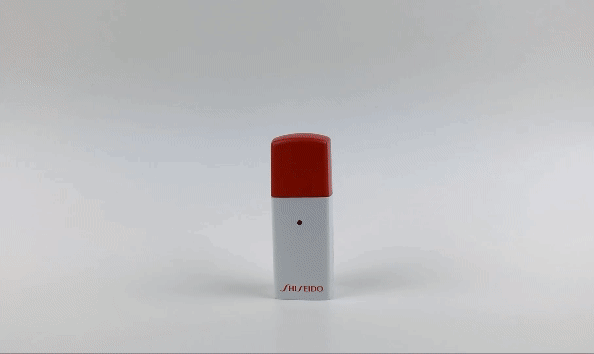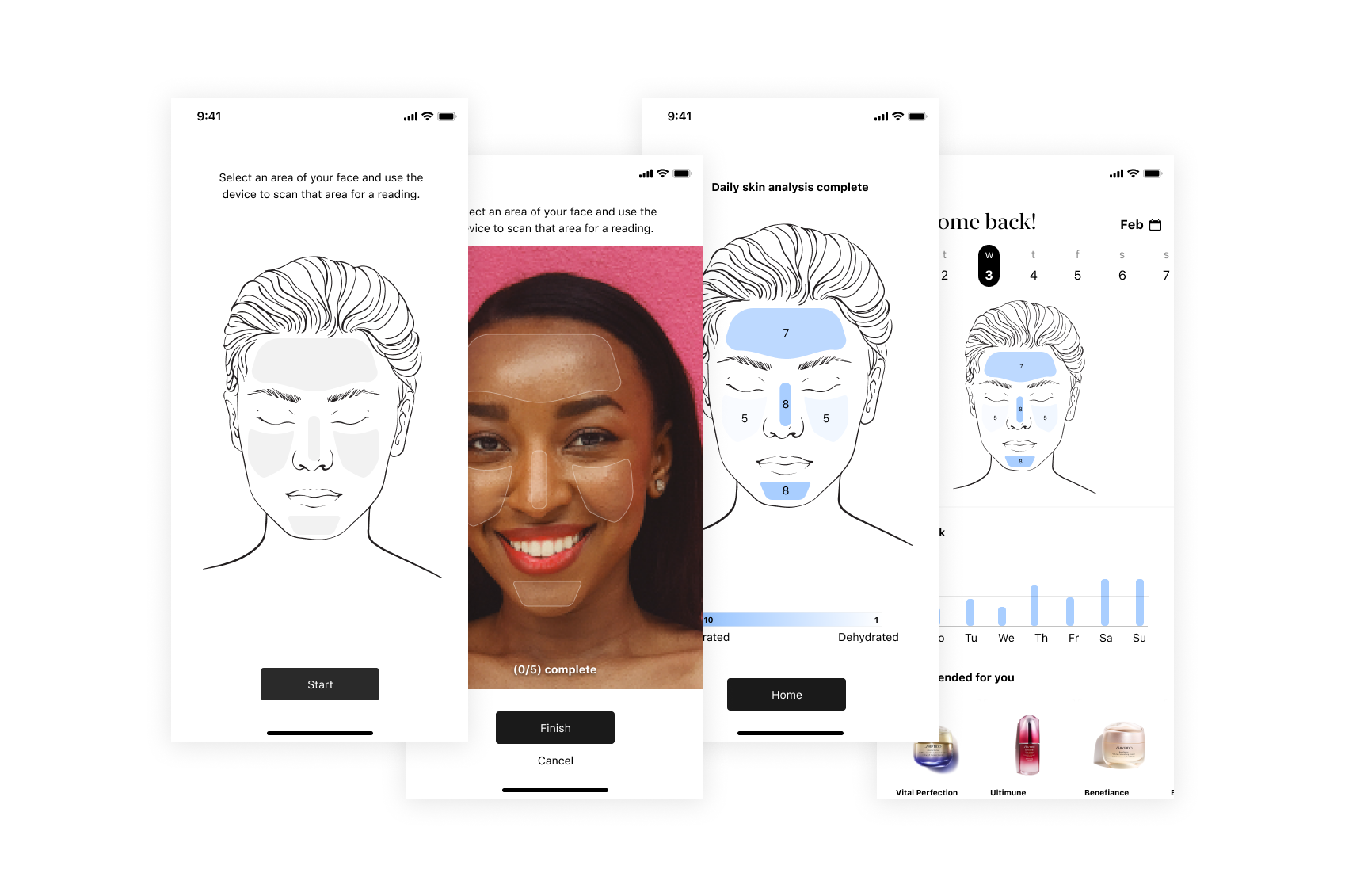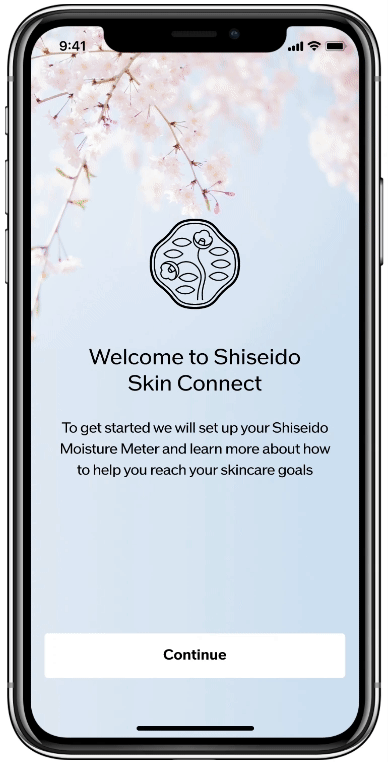Skincare Connect
Shiseido is a Japanese Beauty leader for over 150 years, focused on revolutionary beauty products in skincare, suncare and makeup.
As part of their company mission to create beauty innovations for a better world, Shiseido started an internal innovation hub to explore new ways to leverage technology. We were tasked to bring forward exploration concept projects to share with the many brands in the portfolio. My concept project was focused on leveraging skin reading devices and offer insights to users about how to better care for their skin.
Skincare Connect was a white-label application and accompanying physical skin analysis device that could be leveraged by any brand in the portfolio and scale across multiple languages.
The goal
Leverage the Skincare Connect technology to help users understand the health of their skin, establishing brand expertise for the multiple skincare brands within the Shiseido Group portfolio and long-term customer engagement.
Challenges
-
Each brand had their own teams creating content and managing their brand presence.
The research group within the company was a completely different team limiting our access to consult and engage our domain experts.
The leadership team driving the business objectives and goals for our group was based in Japan and was unable to provide regular check points.
-
With our leadership and research teams in Japan, our manufacturing team in China, and brands across the world, communicating effectively was challenge to tackle to help us move quickly and effectively.
-
To secure approval from leadership to proceed, we set out to create a proof of concept for both the application and physical device. All within a few months' timeframe, we would need to demo these to the leadership team in Japan during the Annual Innovation Summit.
-
As we were starting the project the skincare device was still incomplete and being manufactured in China. Turn around time on feedback and then new versions of the prototypes was something that seemed insurmountable as we began this effort.
Getting the data
At the start we had very little information to go on but needed to make progress if we were going to create a POC by the Summit. The first thing we did was reach out to the Skincare group within our research organization to understand the basics of skincare and what we could help consumers understand about their skin health. From here we were able to outline a basic set of skin health attributes and begin initial designs for what we assumed we could learn from the skin analysis device.
Hydration levels (Water)
Sebum levels (Oil)
Discoloration / hyperpigmentation
Environmental
UV levels
Pollution
Weather
Proof of concept demo
After we created the draft of the skincare metrics, the first version of the skin analysis device came in to begin testing with. This initial device only gave skin hydration readings but future devices would also be able to read sebum levels. At a minimum, having the device meant that the team could begin testing the bluetooth pairing & analysis process of the device.
Initial learnings from users
Device
Had trouble being recognized by phones
Users had to re-pair the device each time they used it to sign into the app
Device gave a wide range of readings
Cap was difficult to remove
Button on the bottom of the device wasn’t obvious for users to find
Users placed the device on different parts of their face between readings resulting in a wide range of results
App
Users felt confused when they completed a scan and didn’t have a gauge for what their readout numbers meant
Users were excited to see specific data to their skin
Even without the addition of brand content or association, users felt confident in their results
White label experience tests
Once we completed multiple rounds of concept testing we started on the first version of the white label app design. This step in between a rough wireframe and high fidelity design allowed us to test if users would be able to navigate the set up and use the device for the first time.
Here we learned even more about how best to take readings with the devices for consistent results.
Users need to place the device in the same place on their face to get a consistent trend of readings
To improve the readings, we recommended that the device be adjusted to allow users to take multiple readings from key areas of the face to produce a wholistic and accurate assessment of a person's skin hydration level per scanning session
Simplifying the numerical output from the device to give a more consumer grade output
Additional context so that users know how to interpret their results
Leveraging user feedback
With these improvements we created the first version of the application which we referred to internally as Skincare Connect. This version allowed us to demo to leadership in Japan and the reception was overwhelmingly positive. We continued to make improvements to the app, start of multiple brand overlays, and the manufacturing team began the final device designs.
The Koishi
The final design for the device incorporated our feedback to consider ergonomics, neutral branding, and enhanced functionality to analyze hydration & sebum levels accurately.
The name means “pebble” in Japanese and was meant to look like a beautiful river stone.
Onboarding
With user feedback integrated, we created a final prototype to introduce users to the app, set up and use their device for the first time, and engage with their results and subsequent recommendations for skin healthcare.
Device setup
Device usage
Showing results
Our goal with the output of the Koishi device was to explain the connection of a person’s life and how it impacts their skin health. To do this without overwhelming users, we created levels of tiers of content in the experience to allow users to dive deeper but still get a high level understanding of their results and actions to take.
Scaling across the brands
The final prototype was then sent for review with the leadership team in Japan where it had an overwhelmingly positive reception. From here we were focused on packaging our work to be shared out with the portfolio of brands to be adopted into their 2021 marketing roadmaps.
This project concluded in March 2020 as the world was going into the COVID pandemic. This ultimately resulted in the innovation hub being disbanded and all projects put on pause. I left the company in this time period but was very proud of the work we did and hope that they are able to pick the Koishi project in the years since.












